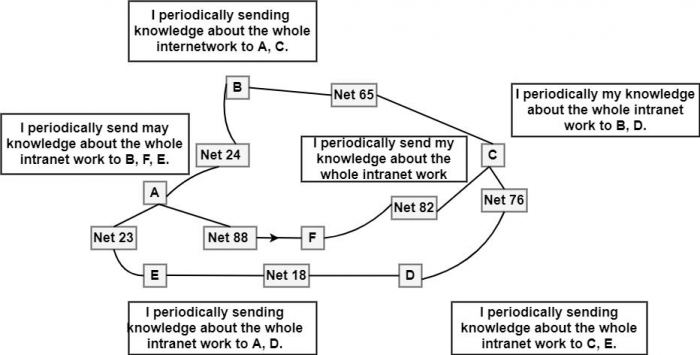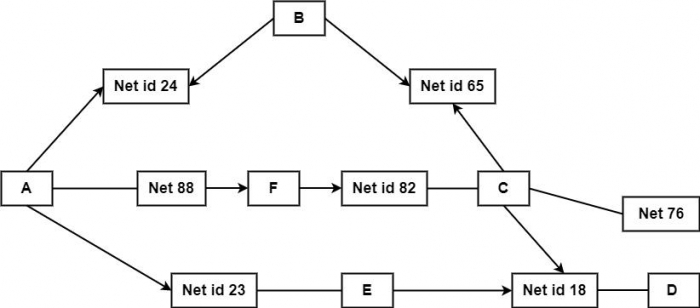
 Data Structure
Data Structure Networking
Networking RDBMS
RDBMS Operating System
Operating System Java
Java MS Excel
MS Excel iOS
iOS HTML
HTML CSS
CSS Android
Android Python
Python C Programming
C Programming C++
C++ C#
C# MongoDB
MongoDB MySQL
MySQL Javascript
Javascript PHP
PHP
- Selected Reading
- UPSC IAS Exams Notes
- Developer's Best Practices
- Questions and Answers
- Effective Resume Writing
- HR Interview Questions
- Computer Glossary
- Who is Who
What is Distance Vector Routing Algorithm?
The Distance-Vector routing algorithm is known by other names. Bellman-Ford routing algorithm and the Ford-Fulkerson algorithm are generally distributed after the researchers create it (Bellman 1957, and Ford and Fulkerson, 1962).
Features
Following are the features of the distance vector routing are −
The routers send the knowledge of the whole autonomous framework.
Sharing of data takes place only with the neighbours.
Sending of data holds place at constant, ordinary intervals, declared every 30 seconds.
In this algorithm, each router evaluates the distance between itself and every achievable destination. This is accomplished by assessing the distance between a router and all of its immediate router neighbours and adding each neighbouring routers computations for the distance between that neighbour and its close neighbours.
Three keys to learn how this algorithm works are as follows −
Knowledge about the entire network
Each router sends its knowledge about the entire network. It communicates all of its connected knowledge about the network to its neighbours.
Routing only to the neighbours
Each route repeatedly shares its knowledge about the network only to those routers with the explicit connection. It transmits whatever knowledge it has about the complete network by all of its parts. This data is taken and stored by each neighbouring router and can upgrade the routers own data about the network.
Information sharing at regular intervals
In distance vector routing, each router repeatedly sends its knowledge about the whole network with its neighbours. For example, after 30 seconds, each router shares its data about its neighbour's entire network.
In this, the rectangular box represents LANs. The number inside each rectangular box is the LANs Network ID. These LANs are linked by a router, described by the boxes such as A, B, C, D, E. The square boxes denote the connection of the routers to their neighbours.
Routing table creation and updating
This table has three columns which contain the information about network id, cost & Next Hop. Let the original tables for each router be.
For router A
| Network id |
Cost |
Next Hop |
|---|---|---|
| 24 |
1 |
B |
| 23 |
1 |
E |
| 88 |
1 |
F |
For router B
| Network id |
Cost |
Next Hop |
|---|---|---|
| 24 |
1 |
A |
| 65 |
1 |
C |
For router E
| Network id |
Cost |
Next Hop |
|---|---|---|
| 23 |
1 |
A |
| 18 |
1 |
D |
For router D
| Network id |
Cost |
Next Hop |
|---|---|---|
| 18 |
1 |
E |
| 76 |
1 |
C |

When A can send his packet or routing table information to B router, E & C directly.
Similarly, B can send routing table information to router A & C and so on.
When A receivers are routing tables from B, E & F, it can update its table. Similarly, B receives A and C updates itself and so on, as shown in the new table.
New routing table for router A
| Network id |
Cost |
Next Hop |
|---|---|---|
| 23 |
1 |
E |
| 24 |
1 |
B |
| 88 |
1 |
F |
| 23 |
2 |
D |
| 38 |
2 |
C |
New routing table for router B
| Network id |
Cost |
Next Hop |
|---|---|---|
| 13 |
2 |
A |
| 24 |
1 |
A |
| 28 |
1 |
C |
| 35 |
2 |
C |
| 38 |
2 |
C |
Similarly, every router will update itself and so on. The updating algorithm checks that the router first adds Hop to the Hop count field for each advertised route. The router should apply these rules.
If the displayed destination is not in the routing table, the router must insert that displayed data into the table.
If the displayed destination is in the routing table, then two things can happen.
If the next-hop field is similar, the router must restore the table's entry with the displayed one.
If the next-hop field is not a similar
If the displayed hop count is lesser than the one on the table, the router must restore the entry in the table with the new one.
If the displayed hop count is not lesser, the router must do nothing.

